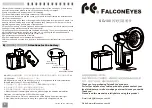
DF4910HD-DN | DDF4910HDV-DN-IM/-SM
www.dallmeier.com
66
Bitrate mode
The bit rate mode allows you to configure a constant (CBR) or a variable bit rate (VBR)
for the video encoding.
The VBR correlates with the changes in the image dynamically.
In scenes with many changes in the image the bit rate is temporarily increased.
The admissible deviations from the defined bit rate are indicated in percentages.
The higher the percentage value, the higher the maximum admissible peak rate and the
longer the regulation time to return to the nominal bit rate.
Example:
In case of a defined (nominal) bit rate of 4 Mbps and a bit rate mode of “variable 100 %”
the peak rate may temporarily increase to up to 8 Mbps.
Variable bit rates allow for a higher image quality while simultaneously enabling a better
use of both available hard disk storage space and transmission capacities.
A constant bit rate on the other hand allows for a more precise calculation of required
storage capacity.
GoP-size
The H.264 coding is carried out by dividing the video stream into so-called GOPs (Group
of Pictures) of a defined length (defined GOP-size).
A GOP sequence always starts with an Intra-Frame (I-Frame), which contains all image
data and serves as a reference for the subsequent images within a GOP.
The I-Frame is compressed with a low compression rate, similar to the JPEG compres-
sion method.
Depending on the defined GOP-size, an I-Frame is followed by one or more Predicted
Frames (P-Frames), which only contain the motion predictions and difference information
about the preceding images (I-Frame or P-Frames) (Long-term prediction).
The compression rate with P-Frames is much higher than with I-Frames since changes
in relation to reference images need to be coded as motion vectors only. The required bit
rate thus decreases so that, with a given total encoding bit rate, more bits are available
for the I-Frame. This means that the quality of the I-Frame can be increased, for example,
the detail resolution in case of a larger GOP-size.
However, if there are scenes with many motion changes, a high number of P-Frames
can have a negative effect on the image quality, because the motion predictions become
increasingly inaccurate.
Additionally, a larger GOP-size always leads to an increase in delays regarding process-
ing or accessing a stream.
The GOP sequence ends before the next I-Frame.
At a later stage, the visible single frames are generated at the decoder, using the indi-
vidual GOPs.
The GOP-size 1 (I-Frames only) indicates a low compression factor and should only be
used with specific applications, because the bandwidth requirements increase signifi
-
cantly.
Generally, a GOP-size of between 6 and 15 will provide a good image quality with suf-
ficient compression.
If large GOP-sizes are defined, reverse playback can result in frame drops with some
decoders.
















































